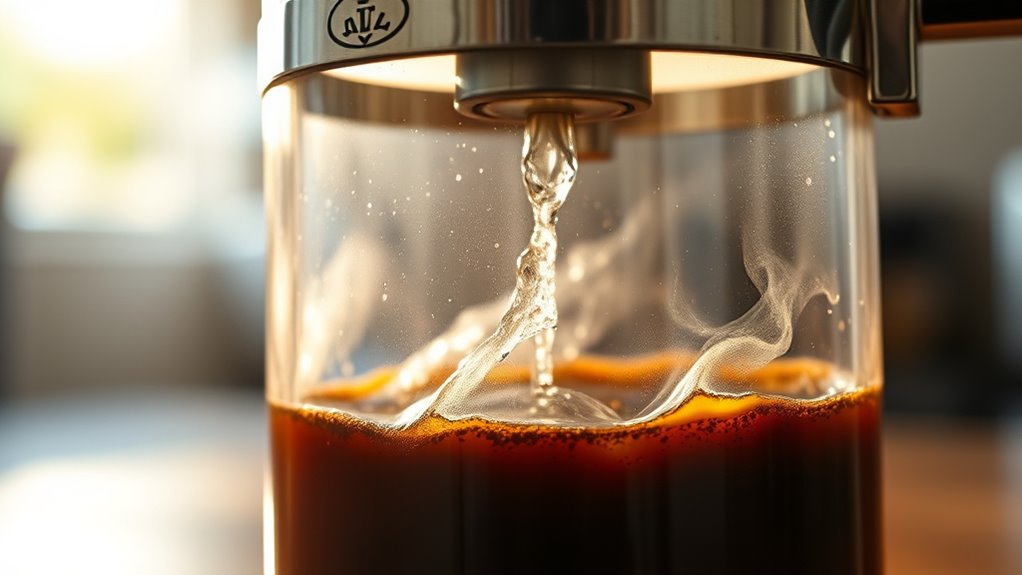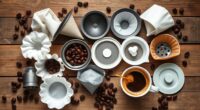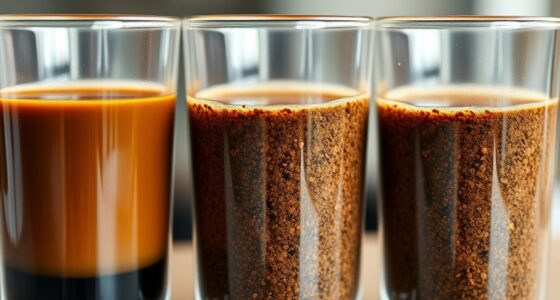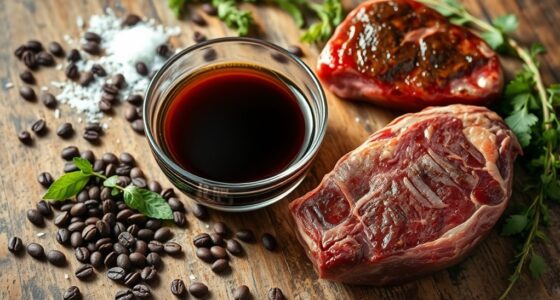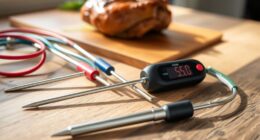The science behind French press brewing lies in the balance of extraction chemistry, grind size, and water temperature. Coarse coffee grounds steep in hot water for 3-8 minutes, allowing soluble flavors to dissolve while avoiding bitterness. Maintaining a water temperature between 195°F and 205°F optimizes extraction. Using the right coffee-to-water ratio enhances flavor too. Master these elements, and you’ll brew a rich, full-bodied cup. Keep going to discover tips for perfecting your French press technique.
Key Takeaways
- The French press uses an immersion brewing method, allowing coffee grounds to steep for optimal flavor extraction without a paper filter.
- Coarse grind size minimizes over-extraction and preserves desirable oils, enhancing the coffee’s texture and flavor complexity.
- Brewing temperature between 195°F and 205°F is crucial for balancing soluble and insoluble compounds, preventing bitterness and sourness.
- Accurate measurements of coffee and water are essential for consistent flavor and preventing common mistakes like over-brewing or incorrect grind size.
- Pouring immediately after pressing improves flavor quality by stopping the extraction process, preventing bitterness from prolonged contact with the grounds.
Understanding the French Press Method
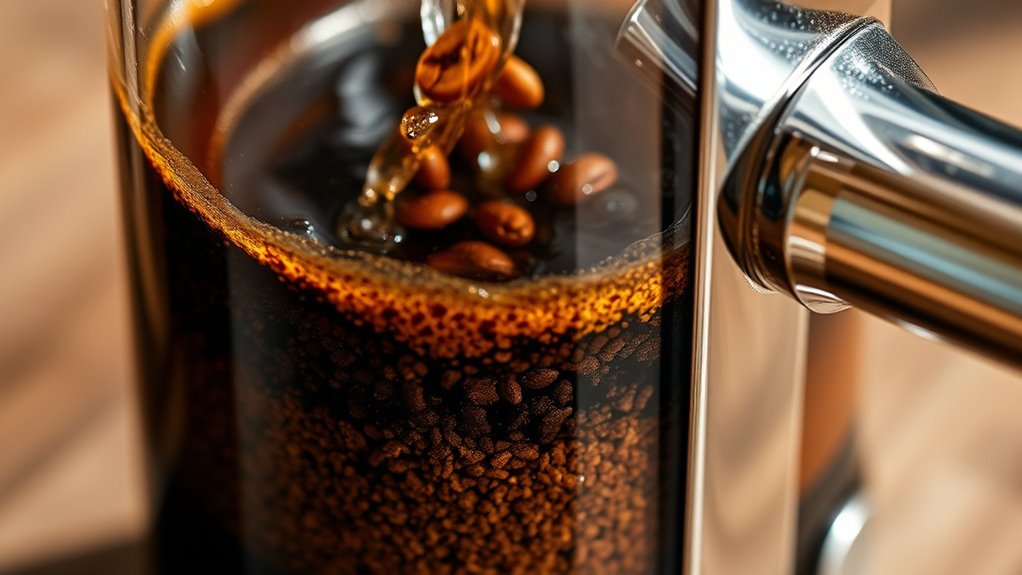
The French press method is a popular choice for coffee lovers who enjoy a full-bodied brew. This immersion brewing process allows coarsely-ground coffee to steep in hot water for 3 to 8 minutes.
You’ll find that longer brewing times can enhance the coffee flavor, but be cautious; over-extraction can lead to bitterness. A good coffee-to-water ratio is about 60 to 70 grams of coffee per liter, which helps achieve ideal extraction.
The lack of a paper filter means the natural oils and fines from the coffee grounds remain in your cup, creating a rich texture and depth.
The absence of a paper filter allows natural oils and fines to enrich your cup, enhancing texture and depth.
To maintain quality, gently press the plunger and pour immediately after brewing, ensuring you savor that exquisite flavor.
The Chemistry of Coffee Extraction
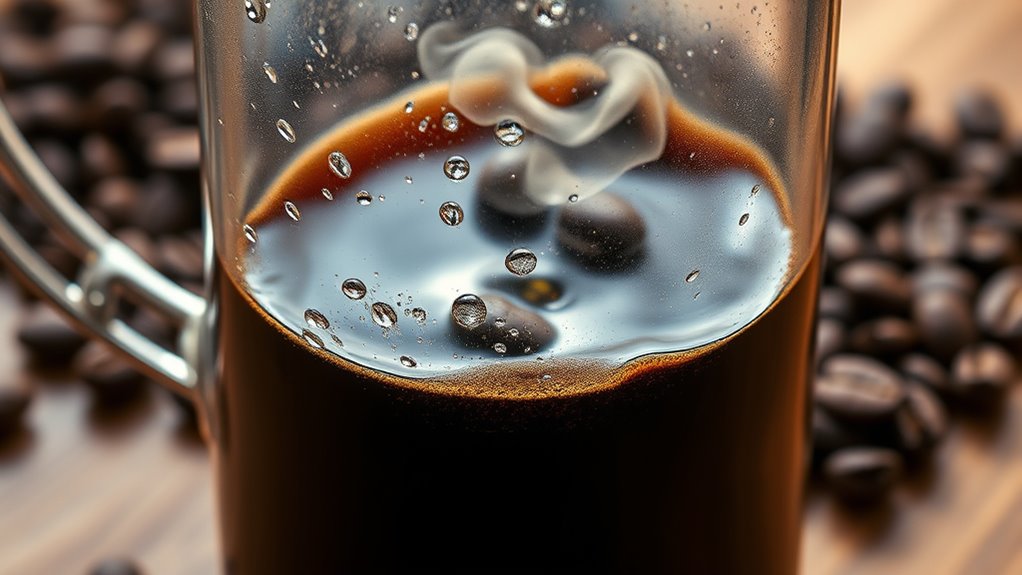
When brewing coffee with a French press, you’re focusing on the balance between soluble and insoluble compounds.
Understanding how different compounds extract at varying rates helps you control the flavor profile of your brew.
Plus, the dynamics of osmosis play an essential role in this gentle extraction process, enhancing the richness of your coffee.
Soluble vs. Insoluble Compounds
Understanding the chemistry behind coffee extraction reveals a fascinating interplay between soluble and insoluble compounds.
When you brew coffee, soluble compounds like fruit acids, caffeine, and lipids dissolve in water, creating flavor and aroma. However, insoluble compounds remain in the grounds, which is essential for your brew’s texture.
If you over-extract, you draw out too many soluble compounds, leading to bitter flavors. On the other hand, under-extraction results in a sour taste.
Using coarsely ground coffee in a French press helps minimize over-extraction, allowing for a balanced extraction that preserves those desirable flavors and oils.
Mastering this balance between soluble and insoluble compounds is key to achieving the perfect cup of French press coffee.
Extraction Rates and Flavor
Mastering the balance of soluble and insoluble compounds in coffee leads to a deeper exploration of extraction rates and flavor. Different coffee compounds dissolve at varying rates, impacting your brew’s taste. For instance, fruit acids and caffeine extract quickly, while carbohydrates and fibers take longer. The French press brewing method facilitates a gentle extraction, preserving natural oils for a fuller-bodied flavor.
To get the best results, pay attention to the coffee-to-water ratio, ideally 1:14 to 1:16.
| Extraction Type | Impact on Flavor |
|---|---|
| Over-Extraction | Bitter, undesirable flavors |
| Under-Extraction | Sour, overly acidic taste |
| Ideal Extraction | Balanced, rich flavors |
| Brewing Temperature | 195°F–205°F (90.5°C–96°C) |
Osmosis and Brewing Dynamics
Osmosis is key in the coffee brewing process, as water moves through the grounds, extracting soluble compounds and creating a flavorful cup.
During brewing, the osmotic pressure helps pull concentrated coffee solutes from the coffee grounds in water, enhancing the overall taste. Different compounds dissolve at varying rates; caffeine and fruit acids extract quickly, while carbohydrates and fibers take longer.
To prevent over-extraction, you need to monitor brewing time, ensuring desirable compounds dissolve without pulling out bitter flavors.
Using coarsely ground coffee in your French press minimizes sediment and preserves oils, further enhancing the brew’s mouthfeel.
Mastering osmosis and extraction dynamics will elevate your coffee experience, allowing you to enjoy a perfectly balanced cup every time.
The Role of Grind Size in Brewing
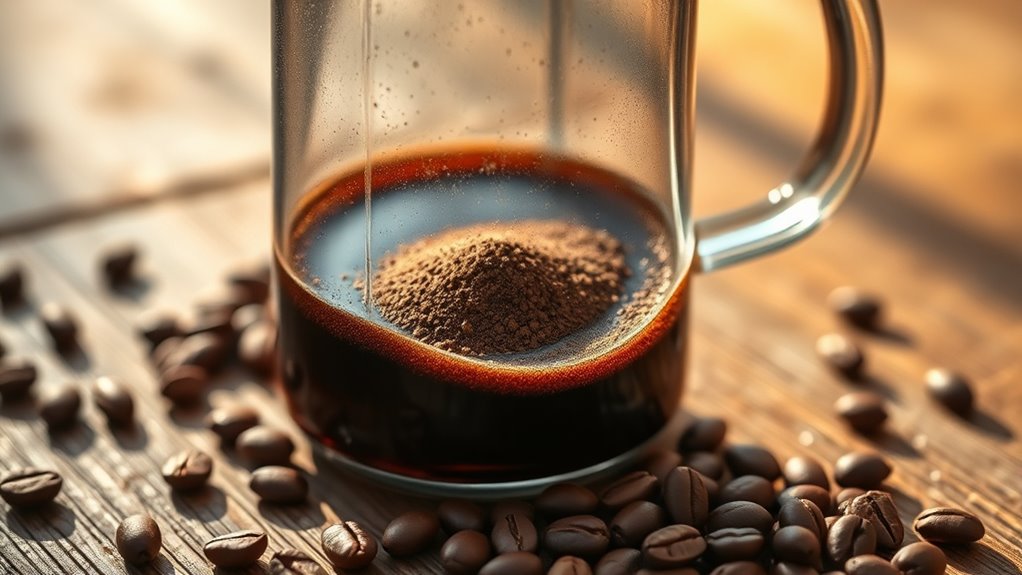
When you brew coffee with a French press, the grind size plays an important role in determining the flavor and quality of your cup. A coarse grind, resembling coarse sea salt or steel-cut oats, minimizes sediment and guarantees ideal extraction.
This coarser grind allows for a slower extraction process, preserving the natural oils and flavors while avoiding bitterness from over-extraction. To achieve the best results, stick to a coffee-to-water ratio between 1:14 and 1:16, or about 60 to 70 grams of coffee per liter of water.
Consistency in grind size is vital; variations can lead to uneven brewing and inconsistent flavors. By mastering grind size, you’ll elevate your French press coffee experience greatly.
Brew Time: Finding the Perfect Balance
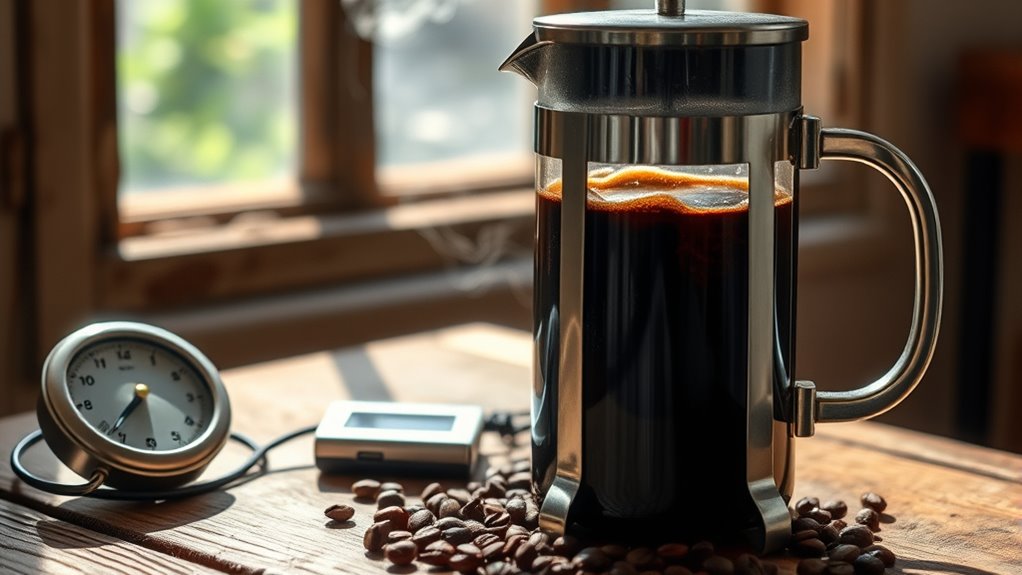
Once you’ve nailed down the right grind size for your French press, the next step is to focus on brew time to achieve that perfect cup.
The conventional brew time ranges from 3 to 4 minutes, but some enthusiasts suggest extending steep times to 6 or 8 minutes for richer flavors.
Shorter brew times help prevent over-extraction, which can lead to bitterness, while longer durations risk drawing out undesirable compounds.
Experimenting with extraction duration allows you to discover your personal flavor preferences.
Remember, coarser grind sizes tolerate longer steeping without over-extraction, while finer grounds need shorter brew times to maintain flavor integrity.
A stopwatch can help you measure brew time accurately, ensuring consistency in your brewing sessions.
Water Temperature and Its Impact on Flavor
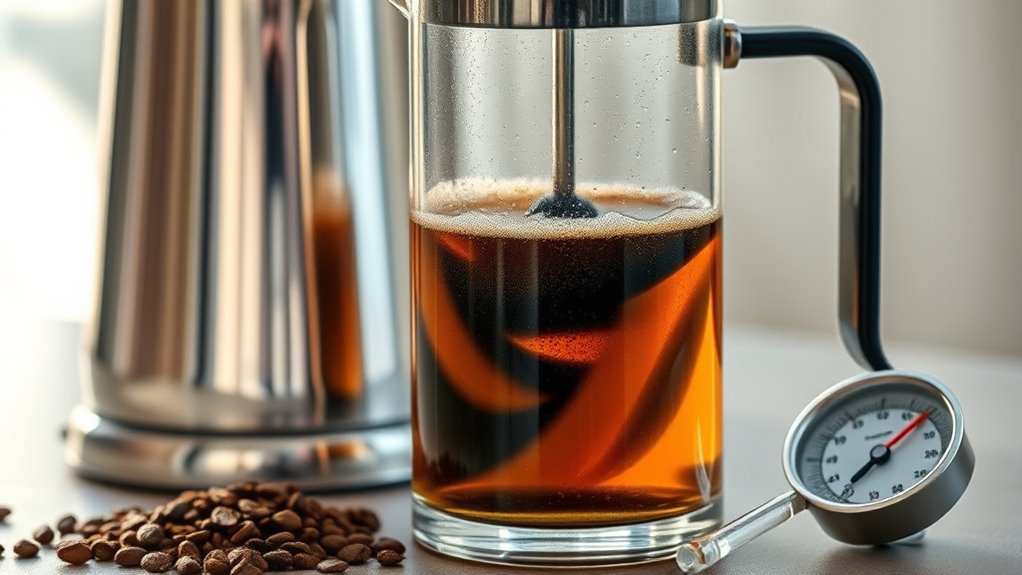
To brew the perfect cup of coffee in your French press, understanding the impact of water temperature is essential. The ideal range is between 195°F and 205°F (90.5°C–96°C), as this effectively extracts flavorful compounds without introducing bitterness.
If your water’s too hot, you risk over-extraction, leading to harsh flavors. On the flip side, water that’s too cool can cause under-extraction, resulting in a sour or overly acidic taste.
To maintain the right temperature, preheat your French press with warm water; this helps prevent the glass from cooling the water too quickly. Additionally, using purified water enhances flavor extraction, ensuring your coffee tastes its best without unwanted impurities affecting the brew.
The Brewing Process: Step-by-Step Guide
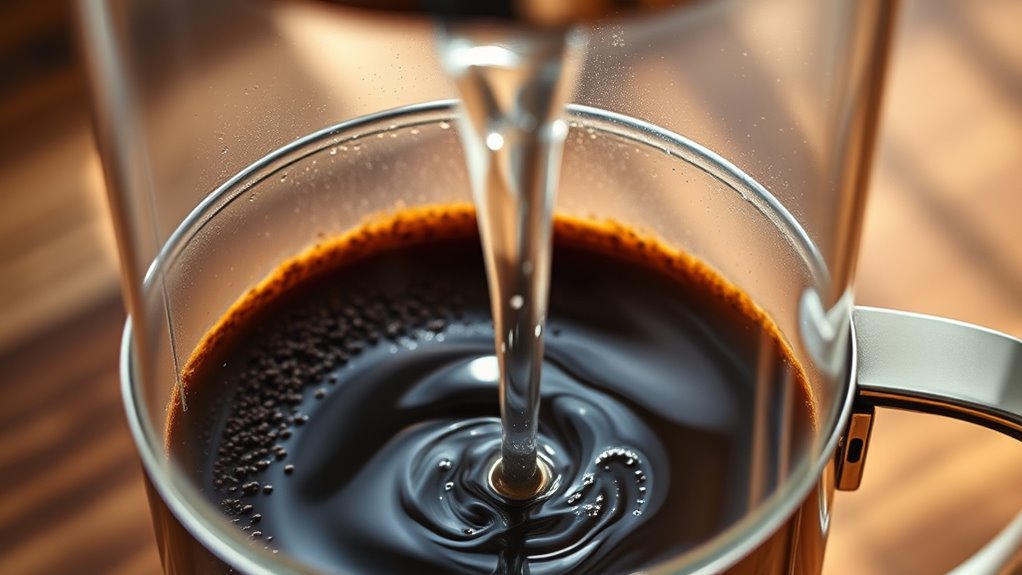
Understanding water temperature plays a key role in brewing, but the process itself is just as important.
Start with coarsely ground coffee, aiming for a texture like coarse sea salt. Use a coffee-to-water ratio of 60-70 grams per liter for ideal flavor extraction. Preheat your French press by swirling warm water in the beaker to maintain temperature.
Start with coarsely ground coffee, using a 60-70 grams per liter ratio, and preheat your French press to enhance flavor.
Next, bloom the coffee by adding a small amount of hot water and letting it sit for 30-45 seconds. After that, pour in the remaining water and steep for 6 to 8 minutes, keeping an eye on the time to avoid bitterness.
Finally, press the plunger down gently to separate the brewed coffee from the grounds, and pour immediately to preserve flavor integrity.
Adjusting Ratios for Optimal Strength
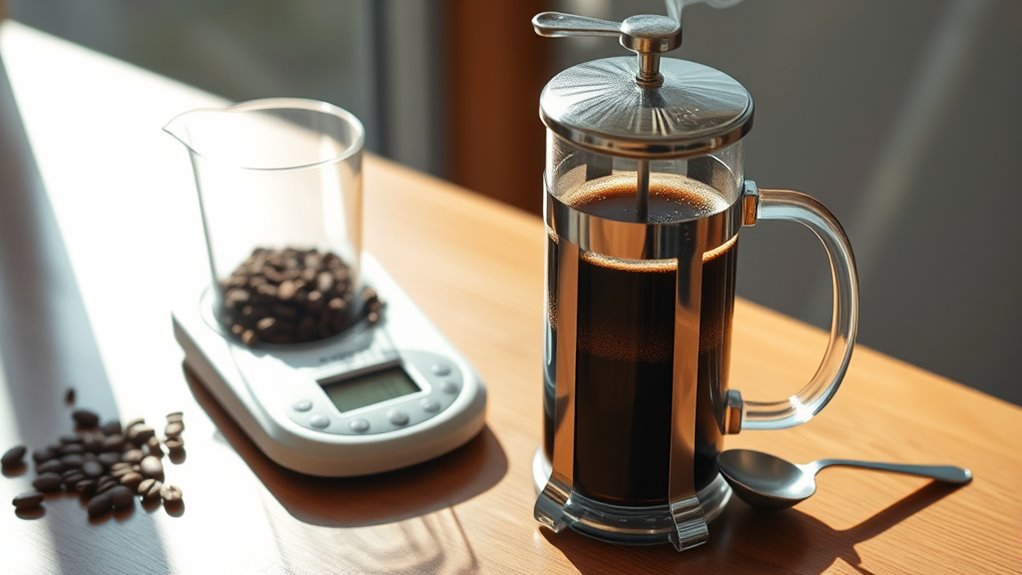
While experimenting with coffee-to-water ratios, you’ll discover how small adjustments can dramatically change the strength and flavor of your brew.
The recommended coffee-to-water ratio for French press brewing ranges from 1:14 to 1:16, which means using about 60-70 grams of coffee per liter of water for ideal strength. If you prefer a stronger cup, start with 1g of coffee to 14-15g of water and adjust from there.
Increasing the brew ratio enhances the extraction of coffee particles, resulting in a bolder flavor. Conversely, using less coffee will yield a milder taste.
Consistent measurements are essential, as even minor variations can greatly impact the extraction quality and overall enjoyment of your coffee.
Common Mistakes in French Press Brewing
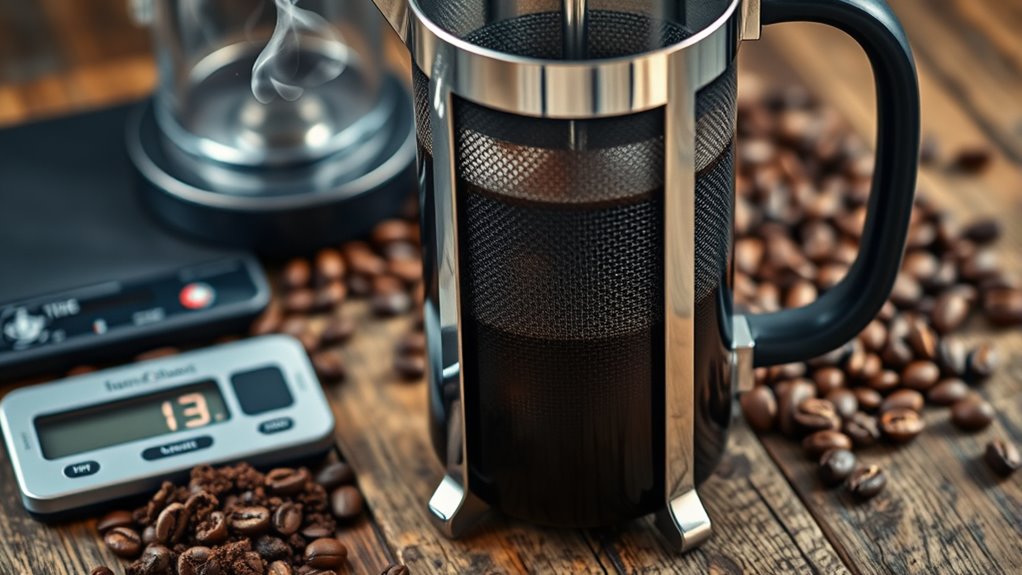
When brewing with a French press, you might be making some common mistakes that affect your coffee’s flavor.
Using the wrong grind size, brewing for too long, or not hitting the right water temperature can all lead to disappointing results.
Let’s explore these pitfalls so you can enjoy a perfect cup every time.
Incorrect Grind Size
One common mistake in French press brewing is using the wrong grind size, which can drastically affect your coffee’s flavor. Here’s what to keep in mind:
- Use coarse coffee grounds: Aim for a grind size that resembles coarse sea salt to avoid bitterness.
- Avoid fine grounds: They can cause over-extraction, resulting in an unpleasant flavor.
- Watch the mesh filter: Fine grounds can clog it, making plunging difficult and risking damage to your French press.
- Maintain consistency: Uneven grind size leads to mixed extraction rates, resulting in a disbalanced cup.
Over-Brewing Duration
Over-brewing in a French press can lead to a bitter and astringent cup of coffee, so it’s important to pay attention to your steeping time.
Typically, over-brewing coffee happens when you steep for longer than 4 to 8 minutes. The ideal brewing time is around 3 to 4 minutes, but if you want to explore complex flavors, you might extend it to 6 or 8 minutes—just be cautious of over-extraction.
The grind size is an important factor; coarser grounds are less prone to bitterness compared to finer ones.
To avoid over-brewing, pour your coffee immediately after plunging. This prevents continued extraction from the grounds, ensuring you enjoy a balanced and flavorful cup.
Improper Water Temperature
Paying attention to water temperature is as important as monitoring your brewing time. Using improper water can lead to disappointing results in your coffee brewing.
Here are some common mistakes to avoid:
- Too Hot: Water above 205°F (96°C) can over-extract, giving your brew a bitter taste.
- Too Cool: Water below 195°F (90.5°C) may under-extract, resulting in a weak or sour flavor.
- Cooling Time: Let boiled water cool for about 30 seconds to hit the ideal 200°F (93.33°C).
- Preheating: Preheat your French press with warm water to maintain temperature during steeping.
Make adjustments to your water temperature, and you’ll greatly enhance the flavor profile and body of your French press coffee.
Enhancing Your French Press Experience

To truly elevate your French press experience, start by mastering the fundamentals of brewing. Use a coffee-to-water ratio of 60 to 70 grams of coarsely ground coffee per liter of water for ideal flavor extraction.
Experiment with brewing times, aiming for 6 to 8 minutes to find the sweet spot that balances flavor complexity without bitterness from over-extraction. Before you begin, preheat your French press with hot water to maintain temperature and guarantee consistent extraction during the brewing time.
After the coffee blooms, gently stir the mixture for 30-45 seconds for even saturation. Finally, pour your coffee immediately after plunging to prevent further extraction, preserving the intended flavor profile and quality of your brew. Enjoy!
Frequently Asked Questions
What’s so Special About French Press Coffee?
French press coffee’s special because it delivers a rich, full-bodied flavor that you won’t get from other brewing methods.
You’re enjoying the natural oils and fine coffee particles that enhance taste and texture, creating a thicker, smoother cup.
The slower steeping process allows for a balanced extraction, minimizing bitterness while maximizing sweetness.
With the right coffee-to-water ratio, you can savor every sip, making your coffee experience truly memorable.
What Are the Disadvantages of a French Press Coffee Maker?
When you use a French press, you might encounter a few disadvantages.
For starters, you’ll notice sediment in your cup, which can affect the taste and texture. If you steep too long, your coffee can turn bitter.
Cleaning it requires more effort, as you need to rinse the mesh filter and beaker thoroughly.
Plus, it doesn’t maintain temperature as well, leading to cooler coffee if you don’t drink it quickly.
Does Coffee Get Stronger the Longer It Steeps in a French Press?
Yes, coffee does get stronger the longer it steeps in a French press, but there’s a catch.
As you extend the steeping time beyond 4 minutes, you risk over-extracting, which can lead to bitterness.
Ideally, you should aim for a balance between desirable flavors and unwanted bitterness.
Experimenting with steeping times will help you find your perfect strength while preserving the smooth, rich taste you enjoy in your coffee.
Why Does Coffee Taste Better in a French Press?
When it comes to coffee, you really can’t judge a book by its cover.
In a French press, the coarsely ground coffee fully immerses in hot water, allowing rich oils and flavors to shine through. This method keeps those natural oils, giving your brew a creamier texture and deeper taste.
Plus, the gentle extraction minimizes bitterness, letting the coffee’s sweetness and complexity take center stage, creating a truly satisfying cup.
Conclusion
In the world of coffee, mastering the French press is like learning to dance; it takes practice but brings joy with every sip. By understanding the science of extraction, grind size, and water temperature, you can craft the perfect brew tailored to your taste. Avoid common pitfalls, and don’t hesitate to experiment with ratios to reveal new flavors. Embrace the journey, and soon you’ll savor each cup as a delightful masterpiece of your own creation.
